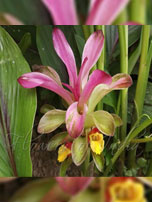Kali Haldi

Botanical Name : Curcuma caesia Roxb.
Family : zingiberaceae
Names in different Indian languages :
English : black turmeric
Hindi : kali haldi
Malayalam : karimanjal
Unani : siyah haldi
Morphology :
Plants have a short stem with large oblong leaves. It bears ovate pyriform or oblong, ovate or cylindrical rhizomes, which are often branched and brownish yellow in color
Distribution and habitat :
The plant originates from India and South-East Asia. It grows in rich humid and clayey soils among them curcuma longa. It is widely cultivated as a medicinal plant in Southeast Asian countries. In India it is found in west Bengal, Madhya Pradesh, Orissa, Chhattisgarh and Uttar Pradesh.
Chemical constituents :
camphor, ar-turmerone, (Z)-ocimene, ar-curcumene, 1,8-cineole , elemene , borneol , bornyl acetate and curcumene
Uses : In the traditional system of medicine, fresh and dried rhizomes of Curcuma caesia are used in treating leucoderma, asthma, tumours, piles, bronchitis, bruises etc. Curcuma caesia has scientifically studied for various therapeutical activities like antioxidant, antibacterial, antipyretic, larvicidal, insecticidal, antimicrobial, wound healing and anti-hyperglycaemic